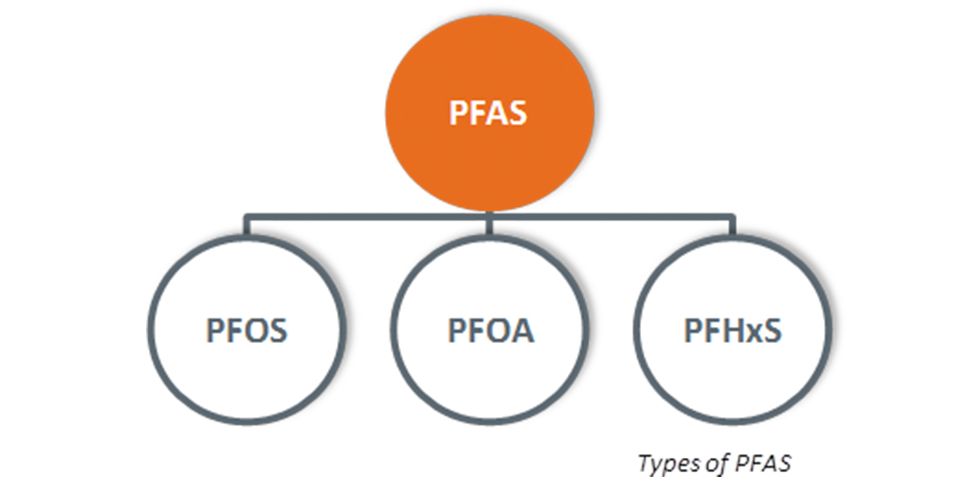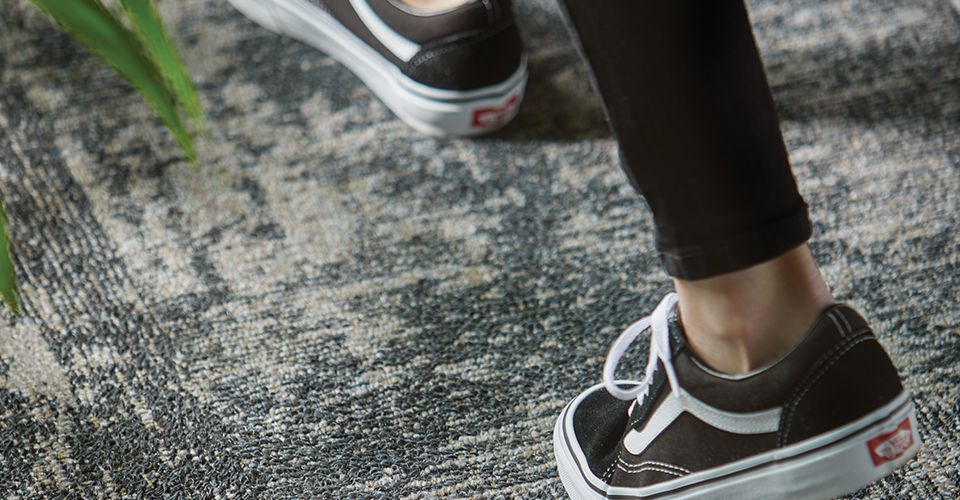Thanks to LEED and other popular green building standards, you know that looking for certified low off-gassing carpet is the first step to selecting a “healthier” carpet. But after “low-VOC,” what do you look for next?
At the moment, the world of commercial interiors is squarely focused on issues of “healthy materials” and product ingredients. So, now is a good time to dispel a few of the more persistent myths around carpet.
Myth #1: ‘PVC-free’ is the number one thing to look for in carpet
Despite the scrutiny from NGOs, PVC is not the number one concern that experts have about chemicals in carpet. Because PVC is an inert plastic, it’s non-toxic to use. Additionally, nearly all controversial additives once associated with flexible vinyl backings (like heavy metals and phthalates) have been phased out of US carpet tile production.
Meanwhile, the carpet industry is only just beginning to address the use of “Forever Chemicals” in their commercial products.
The issue with “Forever Chemicals”
Per-fluorinated chemicals (PFCs or PFAS) don’t break down in the environment. Instead, they end up in ground water, in waterways and even in our own bodies. Essentially, these chemicals are so durable that they never “never fully degrade. Ever. Like, for millennia ever.”
In 2015, hundreds of scientists signed The Madrid Statement, calling for a phase-out of all non-essential uses of PFAS. PFAS chemicals are used in many industries. In some carpet, they’re used on the part of the product that everyone touches: the surface of the fiber. The carpet industry has used PFAS for years to coat yarn for increased stain, soil, and water resistance.
PFAS chemicals have been shown to wear off carpet fibers over time and end up in household and office dust, causing concern about their potential toxicity1. This recently led the State of California to propose regulating PFAS coatings on carpet under the Safer Consumer Products Act.

PFAS is a category of chemicals that don’t break down in the environment. Some of the most-studied members of the PFAS family, PFOS and PFOA, are known to be toxic. Image Credit: Australian Department of Defence
In the US, Interface’s phase-out of PFAS began long before any public outcry. In fact, we transitioned to building permanent stain resistance into all standard nylon yarns through sulfonation in 2010. That means our carpet requires no coatings to perform, and globally, all Interface products are now made without PFAS.
So, while the PVC industry as a whole has issues that can and should be addressed, most scientists would probably say that avoiding highly fluorinated “Forever Chemicals” should be your first priority when selecting carpet.
Myth #2: Red List Free products contain no hazardous ingredients
The Living Building Challenge Red List has become a popular short-cut in recent years for attempting to avoid building products containing hazardous chemicals. But is that really what you get when you choose a “Red List Free” product?
Unfortunately, the answer is no.
The limitations of the Red List
The Red List is a comparatively small list of chemicals and plastics picked by the staff of the Living Building Challenge. However, it doesn’t come close to including all of the carcinogens found in commercial building products — let alone other kinds of toxic chemicals.
For example, going back to Myth #1, the Red List has always banned products containing PVC plastic (including recycled PVC), but it fails to include the vast majority of the PFAS chemicals on the market2. Consequentially, most “Red List Free” carpet currently installed in Living Building Challenge-certified buildings (other than Interface products) could be coated with PFAS stain resistance chemicals.
Notably, the other major “seal of approval” for chemicals in carpet, Cradle to Cradle (C2C), falls short in this area too — its C2C Silver level certification permits carpet products to use PFAS coatings. So even looking for C2C certification doesn’t guarantee a product free of PFAS.
To their credit, both Cradle to Cradle and Living Building Challenge are exploring ways to include more outside science in their upcoming v4.0 iterations. Hopefully, this will close some of these unfortunate loopholes.

Most scientists would probably say that avoiding highly fluorinated “Forever Chemicals” should be your first priority when selecting carpet.
Myth #3: The healthiest carpets are made from natural materials
If you’re speaking of hand-made wool or jute rugs dyed with abundant local minerals or plants, then maybe this is a true statement. But it doesn’t hold true for commercial carpet.
Because, as chemist Michael Braungart likes to say, “God did not design the sheep to resist a red wine stain.”
The downside of natural fibers
The first obstacle is that neither natural dyes nor natural fibers hold up well to heavy foot traffic. So, manufacturers introduced chemical dyes and – you guessed it – PFAS stain resistance treatments. Once coated with PFAS, carpet made with natural fibers loses one of its main attractive features from an environmental standpoint: biodegradability.
As noted in Myth #1, PFAS chemicals are anything but biodegradable.
The second obstacle is that typical industrial production of natural fibers doesn’t fit anyone’s idea of idyllic, pastoral serenity. In the case of wool, there’s soil erosion, GHG “emissions” from sheep and other impacts associated with livestock production. Then, wool must be “de-scaled” to be uniform enough for industrial manufacturing: another chemical- and energy-intensive process.
In the end, industrial systems for natural carpet fiber must be managed carefully to avoid toxic chemical exposures. All this, only to produce fiber that is no longer biodegradable or recyclable and has serious performance issues in commercial environments — especially if you avoid PFAS chemicals.
Beyond the Myths: What should you do?
- Ask manufacturers for ingredients disclosure documents like the Health Product Declaration (HPD) which will give you a more complete picture of the product you are buying than a Red List.
- Ask manufacturers if they have phased out PFAS coatings from their entire business to dig into the company’s overall commitment to “healthy” products.
- Avoid PFAS chemicals by looking for carpet products with yarn that is…
- Solution-dyed, which avoids all the chemicals associated with topically-applied dyes
- Integrally stain resistant (also called “cationic” or “sulfonated”), a permanent alternative to yarn coating chemicals
- High in recycled content. Nothing reduces the environmental impacts and supply chain toxicity of carpet more than using recycled nylon instead of nylon made from virgin petrochemicals.
It’s important to hold manufacturers accountable for the claims they make about ‘healthy” products. While many US-based carpet mills now have commercial carpet options that are PFAS-free due to customer demand, Interface does not use PFAS coatings at all. That means you can choose the products you like with full confidence that you are making a good choice for your health and for the health of the planet we all depend on.
Notes
1 Some of the most-studied members of the PFAS family, PFOS and PFOA, are already known to be toxic.
2 PFOA, PFOS and several others were added in the Red List 3.0 revision several years ago.
9 responses to “Three Big Myths About Chemicals in Carpet”
Mikhail, this is a helpful counterpoint. Thank you for sharing. I appreciate the mention of the HPD Open Standard. The HPD does provide a more complete inventory of a product, as you indicate. I would also hasten to add that the HPD is more than a disclosure document. It is a data feed which any certification or screening program can use to deliver additional analysis of a product. For projects that are seeking to avoid specific chemicals, whether red list, precautionary list, or otherwise, it can provide that data, for example. As you indicated, it can also provide more data, which concerned designers and project teams can use to push the industry further!
I have done research in an area of Bangladesh that grows jute and has large jute mills. Judging from your article, I assume that Interface, which I greatly value, does not use much jute in your production of sustainable carpet tile????
Hi Michael, you are correct. We use high-performance nylon fiber for our carpet tile.
Would you speak to the use of old carpet on garden spaces, or over a drinking water supply/well lot as a weed deterrent, justifying that dangerous compounds have off-gassed, or other compounds are inert?
I would also like to know about this as I regularly use bits of old carpet in conjunction with a tree guards when establishing native plant seedlings in Australia. It has a mulching effect on moisture, suppresses weeds and best of all rabbits can’t dig your seedlings out
I’m in the process of building a raised wicking veg patch. You use carpet in the lining process to protect plastic being punctured. I tried to source old carpet but not luck and ended up with new offcuts. Hung them up and hosed. They FOAMED.
I’ll let them dry and go again till they run clear but they are full of STUFF. Waiting to see if grass dies. May have toxified the back yard. I’ll be going polished concrete in my renovation that’s coming up.
What about other toxins, such as those contained in fire retardants and moth-proofing. Do your products contain those?
your article clear my all doubts about carpets, such a great piece of work. i really admire it.
Hi Mikhail,
Do you know how to test/know if carpeting has PFAS? This is for an older home.. or any practical way to gauge/assess..